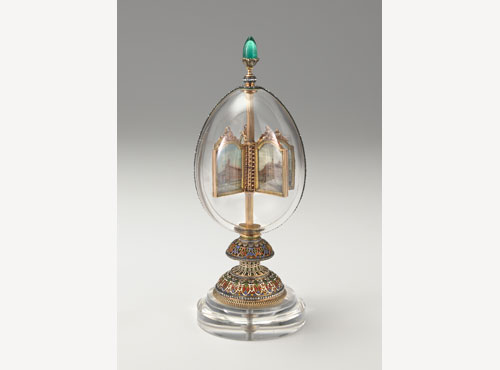In time for Easter, a small collection of Fabergé objects, including the Imperial Rock Crystal Easter Egg, will be on display in the European art galleries. Most of VMFA’s Fabergé and Russian Decorative Arts collection is on international tour, returning to the museum in 2016. Several of the pieces in this display, including the Imperial Easter Egg, were deemed too fragile for travel. This display will remain on view until the newly designed galleries reopen.
About Imperial Easter Eggs
Fabergé’s greatest triumph was a series of 50 unique Easter eggs made for the last tsars of Russia. Inspired by the traditional Russian custom of giving decorated eggs at Easter, each one concealed a surprise designed to delight its recipient. Tsar Alexander III commissioned 10 eggs as Easter presents for his wife, Empress Maria Feodorovna, daughter of the king and queen of Denmark. The first of these—a white enamel hen’s egg—was presented to her in 1885. It opened to reveal a gold yolk, which contained a gold hen. Within the hen were a diamond crown and a diamond-and-ruby pendant. Beginning in 1894, Tsar Nicholas II continued his father’s annual tradition by giving Fabergé Easter eggs to both his mother and his wife, Alexandra Feodorovna. In all, 40 eggs were created for Nicholas II.
Tsar Nicholas II gave the Imperial Rock Crystal Easter Egg to his wife, Tsarina Alexandra Feodorovna, as an Easter gift in 1896—just two months before their coronation. The base of the egg features colorful champlevé enamel and rose-cut diamonds that form the crowned monogram of Princess Alix of Hesse and by Rhine (the tsarina’s title before her marriage) and her later monogram as Empress Alexandra Feodorovna of Russia. It is one of five Imperial Easter eggs in the museum’s collection.
Miniature Paintings
The 12 miniature paintings on ivory by Johannes Zehngraf mounted within the Imperial Rock Crystal Easter Egg depict some of Tsarina Alexandra’s favorite places. For example, Neues Palais in Darmstadt, Germany, was her birthplace. Anichkov Palace, St. Petersburg, was the residence of the Dowager Empress Maria Feodorovna, where newlyweds Nicholas and Alexandra spent their first months together. Windsor Castle, near London, was the residence of Alexandra’s grandmother, Queen Victoria. Nicholas visited his fiancée, Alix (who received the name Alexandra Feodorovna when she officially accepted Russian Orthodoxy), and Queen Victoria at Osborne House, Isle of Wight, in 1894.
• Neues Palais, Darmstadt
• Winter Palace, St. Petersburg
• Schloss Kranichstein, Darmstadt
• Wolfsgarten, near Darmstadt
• Altes Palais, Darmstadt
• Palace Church, Coburg
• Rosenau, Coburg
• Windsor Castle, near London
• Alexander Palace, Tsarskoe Selo
• Balmoral Castle, Scotland
• Anichkov Palace, St. Petersburg
• Osborne House, Isle of Wight
A Brief History of Fabergé
Gustav Fabergé, a craftsman of French-Huguenot origin, founded the Fabergé firm in St. Petersburg, Russia, in 1842. His visionary son Carl (1846–1920) officially took charge of the family jewelry business in the early 1870s. Throughout the next three decades, he transformed the moderately successful enterprise into the internationally acclaimed House of Fabergé
The firm’s first significant breakthrough occurred at the 1882 Pan-Russian Industrial Exhibition in Moscow, when Empress Maria Feodorovna bought a featured pair of cicada-shaped cuff links. Through this connection, Fabergé became Supplier to the Imperial Court in 1885 and created the first of the renowned Imperial Easter eggs. The company quickly expanded, opening branches in Moscow (1887), Odessa (1901), London (1903) and Kiev (1906).
Fabergé created approximately 150,000 works of art, most of them one of a kind. The craftsmanship of the silver and gold objects was matched by the firm’s mastery of antique enameling techniques, as seen in several of the frames on view. Although hardstone objects were acquired from other makers and offered by the company by the 1880s, Fabergé workmen began to carve hardstones themselves in 1908—transforming raw materials such as rock crystal, jasper, nephrite, and purpurine into cane handles, flowers and other small collectibles.
By the time of the 1917 Russian Revolution, Fabergé was the largest enterprise of its type, catering to European royalty, wealthy aristocrats, and business leaders. After Tsar Nicholas II and his family were executed by revolutionaries in 1918, Carl Fabergé fled to Switzerland, where he died in Lausanne in 1920. The large majority of his creations have disappeared. Some were broken up, some melted down, and some destroyed.
Fabergé at the Virginia Museum of Fine Arts
A selection of objects from the firm of Fabergé is on view in this gallery. Between 1933 and 1946, Lillian Thomas Pratt assembled a collection of more than 400 Russian decorative arts objects, including approximately 170 by Fabergé. Born in Philadelphia in 1876, she married General Motors executive John Lee Pratt in 1917, the year the Romanov dynasty fell. In 1933, Lillian Pratt purchased a gilded-silver and mother-of-pearl fork—the first object of her Russian art collection—at Lord & Taylor department store in New York City. After retirement in 1937, the Pratts lived in historic Chatham Manor, across the Rappahannock River from Fredericksburg, Virginia. Lillian Pratt bequeathed her collection of Fabergé and Russian decorative arts to the Virginia Museum of Fine Arts at her death in 1947.
About the Virginia Museum of Fine Arts
VMFA’s permanent collection encompasses more than 33,000 works of art spanning 5,000 years of world history. Its collections of Art Nouveau and Art Deco, English silver, Fabergé, and the art of South Asia are among the finest in the nation. With acclaimed holdings in American, British Sporting, Impressionist and Post-Impressionist, and Modern and Contemporary art – and additional strengths in African, Ancient, East Asian, and European – VMFA ranks as one of the top comprehensive art museums in the United States. Programs include educational activities and studio classes for all ages, plus lively after-hours events. VMFA’s Statewide Partnership program includes traveling exhibitions, artist and teacher workshops, and lectures across the Commonwealth. VMFA, a certified Virginia Green attraction, is open 365 days a year and general admission is always free. For additional information, telephone 804-340-1400 or visit www.vmfa.museum.
# # #
